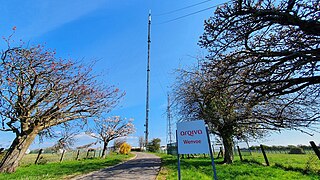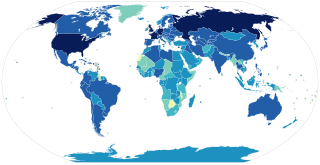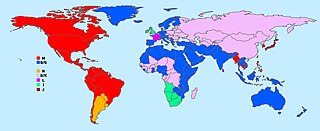Related Research Articles

Analog television is the original television technology that uses analog signals to transmit video and audio. In an analog television broadcast, the brightness, colors and sound are represented by amplitude, phase and frequency of an analog signal.

The first American standard for analog television broadcast was developed by the National Television System Committee (NTSC) in 1941. In 1961, it was assigned the designation System M.

Phase Alternating Line (PAL) is a colour encoding system for analogue television. It was one of three major analogue colour television standards, the others being NTSC and SECAM. In most countries it was broadcast at 625 lines, 50 fields per second, and associated with CCIR analogue broadcast television systems B, D, G, H, I or K. The articles on analog broadcast television systems further describe frame rates, image resolution, and audio modulation.

SECAM, also written SÉCAM, is an analog color television system that was used in France, some parts of Europe and Africa, and Russia. It was one of three major analog color television standards, the others being PAL and NTSC. This page primarily discusses the SECAM colour encoding system. The articles on broadcast television systems and analog television further describe frame rates, image resolution, and audio modulation. SECAM video is composite video because the luminance and chrominance are transmitted together as one signal.

Interlaced video is a technique for doubling the perceived frame rate of a video display without consuming extra bandwidth. The interlaced signal contains two fields of a video frame captured consecutively. This enhances motion perception to the viewer, and reduces flicker by taking advantage of the phi phenomenon.

Colorburst is an analog video, composite video signal generated by a video-signal generator used to keep the chrominance subcarrier synchronized in a color television signal. By synchronizing an oscillator with the colorburst at the back porch (beginning) of each scan line, a television receiver is able to restore the suppressed carrier of the chrominance (color) signals, and in turn decode the color information. The most common use of colorburst is to genlock equipment together as a common reference with a vision mixer in a television studio using a multi-camera setup.
Broadcasttelevision systems are the encoding or formatting systems for the transmission and reception of terrestrial television signals.
The following tables show the frequencies assigned to broadcast television channels in various regions of the world, along with the ITU letter designator for the system used. The frequencies shown are for the analogue video and audio carriers. The channel itself occupies several megahertz of bandwidth. For example, North American channel 1 occupies the spectrum from 44 to 50 MHz. See Broadcast television systems for a table of signal characteristics, including bandwidth, by ITU letter designator.

The Wenvoe transmitting station, officially known as Arqiva Wenvoe, is the main facility for broadcasting and telecommunications for South Wales and the West Country. It is situated close to the village of Wenvoe in the Vale of Glamorgan, Wales, in the UK.
The 405-line monochrome analogue television broadcasting system was the first fully electronic television system to be used in regular broadcasting. The number of television lines influences the image resolution, or quality of the picture.

PAL-M is the analogue colour TV system used in Brazil since early 1972, making it the first South American country to broadcast in colour.

A number of experimental and broadcast pre World War II television systems were tested. The first ones were mechanical based and of very low resolution, sometimes with no sound. Later TV systems were electronic.
819-line was an analog monochrome TV system developed and used in France as television broadcast resumed after World War II. Transmissions started in 1949 and were active up to 1985, although limited to France, Belgium and Luxembourg. It is associated with CCIR System E and F.

441-line is the number of scan lines in some early electronic monochrome analog television systems. Systems with this number of lines were used with 25 interlaced frames per second in France from 1937 to 1956, Germany from 1939 to 1943, Italy from 1939 to 1940, as well as by RCA in the United States with 30 interlaced frames per second from 1938 to 1941. Broadcasts were planned in Finland for 1940, but eventually cancelled due to World War II. Some experiments with similar systems were carried out on the USSR in the 1930s and Japan in 1939.

CCIR System B was the 625-line VHF analog broadcast television system which at its peak was adopted by more than one hundred countries, either with PAL or SECAM colour. It's usually associated with CCIR System G for UHF broadcasts.

625-line is a late 1940s European analog standard-definition television resolution standard. It consists of a 625-line raster, with 576 lines carrying the visible image at 25 interlaced frames per second. It was eventually adopted by countries using 50 Hz utility frequency as regular TV broadcasts resumed after World War II. With the introduction of color television in the 1960s, it became associated with the PAL and SECAM analog color systems.

CCIR System H is an analog broadcast television system used in Belgium, Bosnia and Herzegovina, Croatia, Malta, Slovenia and Liberia on UHF bands, paired with System B on VHF. It was associated with PAL colour.
CCIR System A was the 405-line analog broadcast television system adopted in the UK and Ireland. System A service started in 1936 and was discontinued in 1985.

CCIR System I is an analogue broadcast television system. It was first used in the Republic of Ireland starting in December 1961 as the 625-line broadcasting standard to be used on VHF Band I and Band III, sharing Band III with 405-line System A signals radiated in the north and east of the country. The Republic of Ireland has (slowly) extended its use of System I onto the UHF bands.
375-line corresponds to two different electronic television systems, both using 375 scan lines. One system was used in Germany after 1936 along with the 180-line system, being replaced in a few years by the superior 441-line system. It was also tested in Italy around the same time.
References
- ↑ "Philips bringt ein neues Fernsehsystem". Funktechnik. No. 2. Austria. 1948.
- ↑ "Philips bringt ein neues Fernsehsystem". Funktechnik. No. 2. Austria. 1948.
- ↑ Fernsehen. doi:10.1007/978-3-642-92591-7.
- ↑ "Philips Netherland 567 line TV Standard" (in German). Radiomuseum.org. Retrieved 2011-06-20.
- ↑ J. van der Mark (January 1938). "A transportable television installation" (PDF). Philips Technical Review. 3 (1): 2.
The installation is suitable for the broadcasting of 25 pictures per second, with 405 or 567 lines per complete picture, while interlaced scanning is employed. (If 567 lines are used, a frequency spectrum must be dealt with which extends from about 50 cycles per second to about 5 × 106 cycles per second, for 405 lines the necessary frequency spectrum extends only to 2.5·106 cycles per second.
- 1 2 Scheida, W. (2006). "Fernsehen in Holland - in den Niederlanden". Virtuelles Museum des Fernsehens. Retrieved 2011-06-20.
- ↑ "Philips TX594U - Television receiver for experimental broadcast, VHF channel 4 only, 567 lines". Radiomuseum.